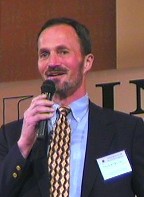-
(b.) - ?1943 October 07
Bio/Description
Author of the "Kryder?s Law", in which he pointed out that if scaling magnetic recording continued at the current rate, it would hit a limit where thermal energy would cause recordings to decay over time frames of less than five years. Information storage has been his interest for most of his career. As founder and Director of Carnegie Mellon University's Data Storage Systems Center and as Chief Technology Officer at hard-drive manufacturer Seagate Technology, he has often spearheaded the breakthroughs that have increased hard-disk densities (and accelerated their corresponding drop in price). But these days, he says, altogether unexpected trends are afoot: smaller, high-capacity drives are spawning not only new products and applications but entirely new industries. Over the years there has been a lot of talk about Moore's Law and the way that doubling the power and memory of computer semiconductors every 18 months has driven technological advance. But he projected; another force is at least as powerful, perhaps more: the cramming of as many bits as possible onto shrinking magnetic hard drives. Since the introduction of the disk drive in 1956, the density of information it can record has swelled from a meagre 2,000 bits to 100 billion bits (gigabits), all crowded in the small space of a square inch. That represents a 50-million-fold increase. Not even Moore's silicon chips can boast that kind of progress. Born in Portland, Oregon), he received his Bachelor of Science degree (1965) in Electrical Engineering from Stanford University; his M.S. degree in 1966 from the California Institute of Technology (Caltech) and in 1970 he earned his Ph.D., in Electrical Engineering and Physics, also from Caltech. It was there that he began exploring digital storage. From 1973 to 1975 he was at the IBM Thomas J. Watson Research Center, where as Manager of Exploratory Bubble Devices, he researched bubble memory, which records data by magnetizing small circles on gadolinium gallium garnet. In 1978 he joined Carnegie Mellon University, as an Associate Professor, where he continued his bubble memory work, but it became clear that the technology, used in cruise missiles and other niche applications, faced as obstacle as a mainstream product: gadolinium gallium garnet was expensive. When the fledgling personal computer industry made the hard drive its storage device of choice, he switched gears, assembled a conference of hard-drive industry gurus in 1982, and asked them to name their greatest research needs. Next he persuaded businesses such as IBM and 3M to support an effort to develop those technologies. The result in 1983: the Magnetics Technology Center (MTC), the only operation of its kind in the U.S. For the next five years, the center incubated increasingly efficient hard-drive technologies, while cultivating the field's top thinkers. In 1980, he became Professor of Electrical Engineering and founder of the Computer Engineering, Data Storage Systems Center. In 1983 he was appointed Director, Magnetics Technology Center and in 1990, the Director, Data Storage Systems Center until 1998. With the area density of recording on hard disk drives increasing at a rate of 60 percent annually, he had only a few years to find a new technology. He was hired by Seagate Corporation in 1998 and started a new research center for the company in Pittsburgh. He worked as Senior Vice President of Research and Chief Technology Officer until 2003. As a result of the research, Seagate began producing disk drives based on perpendicular recording technology in 2005 and within a couple of years the entire hard disk drive industry had changed from longitudinal to perpendicular recording. A 2005 Scientific American article, titled "Kryder's Law", observed that magnetic disk areal storage density was then increasing very quickly. The pace was then much faster than the two-year doubling time of semiconductor chip density posited by Moore's law. Inside of a decade and a half, hard disks had increased their capacity 1,000-fold, a rate that Intel founder Gordon Moore himself has called "flabbergasting." In 2005, commodity drive density of 110 Gbit/in2 (170 Mbit/mm2) had been reached, up from 100 Mbit/in2 circa 1990. This does not extrapolate back to the initial 2 kilobit/in2 drives introduced in 1956, as growth rates surged during the latter 15-year period. It is said that advances in storage capacity since 2005, are largely responsible for "the cloud" and social media. In 2009 he projected that if hard drives were to continue to progress at their then-current pace of about 40% per year, then in 2020 a two-platter, 2.5-inch disk drive would store approximately 40 terabytes (TB) and cost about $40. The validity of the Kryder's law projection of 2009 was questioned halfway into the forecast period, and some called the actual rate of areal density progress the "Kryder rate". As of 2014, the observed Kryder rate had fallen well short of the 2009 forecast of 40% per year. A single 2.5-inch platter stored around 0.3 terabytes in 2009 and this reached 0.6 terabytes in 2014. The Kryder rate over the five years ending in 2014 was around 15% per year. To reach 20 terabytes by 2020, starting in 2014, would require an implausibly high Kryder rate of better than 80% per year. Among his awards and honors are: Elected member of the National Academy of Engineering, a Fellow of the American Physical Society and a Fellow of the Institute of Electrical and Electronic Engineers (IEEE). He was Distinguished Lecturer for the IEEE Magnetics Society, and has been awarded the IEEE Magnetics Society Achievement Award and IEEE Reynold B. Johnson Information Storage Systems Award. He received the Pingat Bakti Masyarakat from Singapore in their 2007 National Day Awards. He received the American Physical Society, George E. Pake Prize, also in 2007.
-
Date of Birth:
1943 October 07 -
Noted For:
Spear header of the breakthroughs that have increased hard-disk densities (and accelerated their corresponding drop in price) -
Category of Achievement:
-
More Info:


